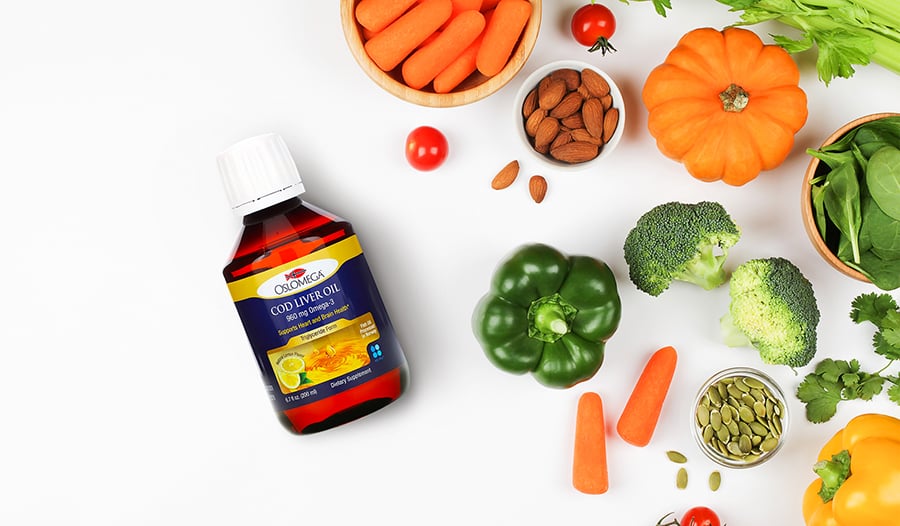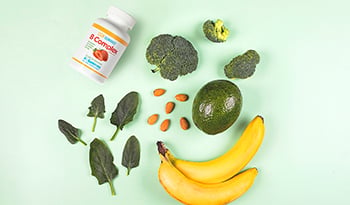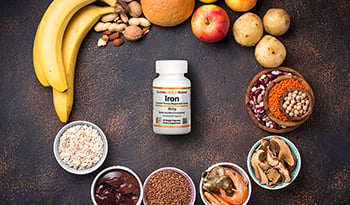Which Foods Are High in Vitamin A?
DISCLAIMER:This blog does not intend to provide diagnosis...
- In this article:
- What Is Vitamin A?
- The Function of Vitamin A
- How Much Vitamin A Do You Need?
- Deficiency of Vitamin A
- Excess Vitamin A
- Food Sources of Vitamin A
- Takeaway

What Is Vitamin A?
Vitamin A is a fat-soluble vitamin needed for maintaining health. As a term, vitamin A includes a group of related compounds including active vitamin A and its precursors, the provitamin A carotenoids.
Vitamin A is found in both animal and plant foods, although in different forms. One of the active forms of the vitamin, retinol, is found in animal products like meat and eggs. The precursors, or “provitamin” forms of the vitamin, include the carotenoids beta-carotene, alpha-carotene, and beta-cryptoxanthin. Carotenoids are found in plants and often give yellow-orange coloration to different fruits and vegetables.
The Function of Vitamin A
Vitamin A is needed for cellular growth and development. It also plays a critical role in vision, immune function, reproduction, bone health, and gene regulation. The vitamin is of crucial necessity during childhood development. In countries with poor levels of vitamin A in the diet, supplementation has been shown to reduce childhood deaths from any cause by 24%. In severely deficient children, eye damage can develop leading to blindness. Researchers have recommended that all children at risk for deficiency be supplemented with vitamin A due to the large benefits that have been found.
One of the main effects of vitamin A is the genetic regulation of cellular differentiation. When cells develop, they often differentiate. This process allows a cell to become specialized, like a muscle or nerve cell. Vitamin A is necessary for the production of differentiated cells throughout the body.
Bone health is also reliant on the vitamin, although the dose of active vitamin A is critical. Research suggests that consuming both too little and too much of the active form of the vitamin increases risks for osteoporosis. However, the risks for too much vitamin A do not appear to apply to provitamin A carotenoids from food, as they correlate with a decreased risk of osteoporosis with increasing consumption.
Provitamin A carotenoids also have been correlated, in some studies, with decreased risks for cognitive decline and dementia. However, in order to derive significant preventative effects with carotenoids, the research suggests that long-term consumption over many years is likely necessary.
How Much Vitamin A Do You Need?
Since active vitamin A and provitamin A carotenoids have different efficacy as vitamin A, the term retinol activity equivalents (RAE) was developed to allow for comparison. This simplifies nutritional labels as a food's vitamin A levels are measured in RAE.
While it may get somewhat confusing, one microgram of retinol (active vitamin A) is equal to one microgram RAE. For supplemental beta-carotene, two micrograms count as one microgram RAE. From plant sources, such as fruits and vegetables, the RAEs are much lower. It takes 12 micrograms of beta-carotene from food to count as one microgram RAE and 24 micrograms of either alpha-carotene or beta-cryptoxanthin to count as one microgram RAE.
Recommendations for daily retinol activity equivalents (RAE) based on age and sex:
- Birth to 6 months: 400 mcg RAE
- 7-12 months: 500 mcg RAE
- 1-3 years: 300 mcg RAE
- 4-8 years: 400 mcg RAE
- 9-13 years: 600 mcg RAE
- 14+ years old female: 700 mcg RAE
- 14+ years old male: 900 mcg RAE
- 14-18-year-old female, pregnancy and lactation: 750 and 1200 mcg RAE
- 19-50-year-old female, pregnancy and lactation: 770 and 1300 mcg RAE
Deficiency of Vitamin A
As previously covered, vitamin A is crucial for developing children and deficiency can lead to increased susceptibility to infections, blindness, skin rashes, and other developmental abnormalities. Low vitamin A has also been shown to increase risks for bone loss and osteoporosis.
Excess Vitamin A
Too much active vitamin A, in rare cases, can be fatal. However, cases of fatal vitamin A overdose require very high levels of consumption. At lower levels, excess active vitamin A has also been associated with bone loss, especially in individuals that have vitamin D deficiency or struggle with obesity. Interestingly, provitamin A carotenoids do not appear to increase bone loss, with some research suggesting that they may actually be protective. A study out of Japan found that women with the highest blood levels of beta-carotene and beta-cryptoxanthin had a 76% and a 93% reduction in the risk of osteoporosis respectively.
As for carotenoids, excess provitamin A can cause a harmless orange coloration. When consumed in large quantities, carotenoids are deposited in the skin. While not a perfect test, you can often get a sense of a person’s carotenoid consumption by the level of orange coloration in the palms of their hand. Even with high-level consumption, carotenoids from food sources appear to be quite safe.
Food Sources of Vitamin A
Multiple food sources provide vitamin A, either as active vitamin A or as the provitamin a carotenoids.
Active Vitamin A
Active vitamin A, or retinol, is found in a number of animal-based food products. Meat, eggs, seafood, poultry, and dairy products all contain active vitamin A. Liver is quite high in active vitamin A and cod liver oil is a particularly rich source.
Provitamin A Carotenoids
Getting vitamin A from beta-carotene and other provitamin-A, carotenoid-rich foods is likely the safest approach to vitamin A supplementation for two reasons. First, as previously mentioned, it is possible to consume too much retinol or active vitamin A. Fortunately, provitamin A carotenoids from food don’t appear to have a toxic threshold.
While food-based carotenoids have been correlated with significant health benefits, synthetic beta-carotene supplements appear to carry some risks. A study in smokers found an increased risk of cancer and death with synthetic beta-carotene supplementation. Yet diets high in beta-carotene from food have been shown to decrease the risks of heart disease and other chronic diseases.
While not proven, the problem with synthetic beta-carotene could be due to differences in the synthetic form as compared to natural beta-carotene. Natural beta-carotene comes in two forms, while synthetic beta-carotene is only composed of one. In general, the safest approach is to consume foods high in provitamin A carotenoids to avoid issues with synthetic beta-carotene supplements and too much active vitamin A.
Provitamin A Food Sources
Foods that are deep orange to yellow in color are often rich sources of provitamin A. Carrots, pumpkin, winter squash, sweet potatoes, apricots, cantaloupe, dark leafy greens, bell peppers, grapefruit, and broccoli are all good sources of provitamin A carotenoids.
Superfood Sources
A number of so-called superfoods are also rich in carotenoids. Red palm oil has extremely high levels. It contains 15 times more vitamin A than carrots and 44 times more than leafy greens. The deep red color of the oil is characteristic of high carotenoid content.
Another rich source of provitamin A is goji berries. Originally from Asia, these berries have often been touted for their anti-aging benefits in Chinese herbal medicine. The berries are quite rich in carotenoids and have about four times the beta-carotene content of carrots. They are also extremely rich in another carotenoid potentially important for eye health: zeaxanthin.
In South America, a plant in the same family as goji berries is also a good source. Ground cherries or golden berries are a tart fruit with a golden orange color, again indicative of their carotenoid content. Depending on growing conditions and the variety, they typically contain anywhere from a similar amount of beta-carotene as carrots to 10 times as much. Like goji berries, they are also very rich in zeaxanthin.
Spirulina and chlorella, two edible algae, are also very rich sources of carotenoids. By weight, spirulina has over 50 times more beta-carotene than carrots. Chlorella comes in a close second, with slightly less. Both types of algae are also rich in other vitamins, minerals, and protein.
Spices
A number of common spices are particularly rich sources of provitamin A. Paprika and cayenne pepper are both loaded with beta-carotene. Basal, parsley, marjoram, and oregano also have significant beta-carotene content. Spices can be a simple way to add flavor and additional nutrients to food.
Takeaway
Vitamin A comes in two main forms, active vitamin A, which comes from animal products, and provitamin A carotenoids, found in plants. Vitamin A is important for cellular differentiation, immune function, bone health, reproduction, gene regulation, and vision. While it appears that you can consume too much active vitamin A, the provitamin A carotenoids, when derived from food, appear quite safe. Research suggests that they also have significant health benefits, including protection from heart disease, osteoporosis, other chronic diseases, and dementia. Consuming foods and superfoods known to be rich in provitamin A is likely an effective strategy to help promote health.
References:
- Ben-Amotz A, Levy Y. Bioavailability of a natural isomer mixture compared with synthetic all-trans beta-carotene in human serum. Am J Clin Nutr. 1996 May;63(5):729-34. doi: 10.1093/ajcn/63.5.729. PMID: 8615356.
- Briones-Labarca V, Giovagnoli-Vicuña C, Figueroa-Alvarez P, Quispe-Fuentes I, Pérez-Won M. Extraction of Beta-Carotene, Vitamin C and Antioxidant Compounds from Physalis peruviana (Cape Gooseberry) Assisted by High Hydrostatic Pressure. Food and Nutr Sci. 2013;4(8A). doi:10.4236/fns.2013.48A014
- Edem DO. Vitamin A: A Review. Asian J Clin Nutr. 2009;1(1):65-82.
- Georgiopoulou I, Tzima S, Pappa GD, Louli V, Voutsas E, Magoulas K. Experimental Design and Optimization of Recovering Bioactive Compounds from Chlorella vulgaris through Conventional Extraction. Molecules. 2021;27(1):29. Published 2021 Dec 22. doi:10.3390/molecules27010029
- Kritchevsky SB. beta-Carotene, carotenoids and the prevention of coronary heart disease. J Nutr. 1999 Jan;129(1):5-8. doi: 10.1093/jn/129.1.5. PMID: 9915867.
- Levin G, Mokady S. Antioxidant activity of 9-cis compared to all-trans beta-carotene in vitro. Free Radic Biol Med. 1994 Jul;17(1):77-82. doi: 10.1016/0891-5849(94)90009-4. PMID: 7959168.
- Li X, Holt RR, Keen CL, Morse LS, Yiu G, Hackman RM. Goji Berry Intake Increases Macular Pigment Optical Density in Healthy Adults: A Randomized Pilot Trial. Nutrients. 2021 Dec 9;13(12):4409. doi: 10.3390/nu13124409. PMID: 34959963; PMCID: PMC8708314.
- Liestianty D et al. Nutritional analysis of spirulina sp to promote as superfood candidate. IOP Conf Ser: Mater Sci Eng. 2019.
- Loganathan R, Subramaniam KM, Radhakrishnan AK, Choo YM, Teng KT. Health-promoting effects of red palm oil: evidence from animal and human studies. Nutr Rev. 2017 Feb 1;75(2):98-113. doi: 10.1093/nutrit/nuw054. PMID: 28158744.
- Ma ZF, Zhang H, Teh SS, et al. Goji Berries as a Potential Natural Antioxidant Medicine: An Insight into Their Molecular Mechanisms of Action. Oxid Med Cell Longev. 2019;2019:2437397. Published 2019 Jan 9. doi:10.1155/2019/2437397
- Mayo-Wilson E, Imdad A, Herzer K, Yakoob MY, Bhutta ZA. Vitamin A supplements for preventing mortality, illness, and blindness in children aged under 5: systematic review and meta-analysis. BMJ. 2011;343:d5094. Published 2011 Aug 25. doi:10.1136/bmj.d5094
- National Institutes of Health. Vitamin A. Updated March 26, 2021. Accessed February 8, 2022. https://ods.od.nih.gov/factsheets/VitaminA-HealthProfessional/
- Omenn GS, Goodman GE, Thornquist MD, Balmes J, Cullen MR, Glass A, Keogh JP, Meyskens FL Jr, Valanis B, Williams JH Jr, Barnhart S, Cherniack MG, Brodkin CA, Hammar S. Risk factors for lung cancer and for intervention effects in CARET, the Beta-Carotene and Retinol Efficacy Trial. J Natl Cancer Inst. 1996 Nov 6;88(21):1550-9. doi: 10.1093/jnci/88.21.1550. PMID: 8901853.
- Rutjes AW, Denton DA, Di Nisio M, Chong LY, Abraham RP, Al-Assaf AS, Anderson JL, Malik MA, Vernooij RW, Martínez G, Tabet N, McCleery J. Vitamin and mineral supplementation for maintaining cognitive function in cognitively healthy people in mid and late life. Cochrane Database Syst Rev. 2018 Dec 17;12(12):CD011906. doi: 10.1002/14651858.CD011906.pub2. PMID: 30556597; PMCID: PMC6353240.
- Self. Nutrition Data. Accessed February 9, 2022. https://nutritiondata.self.com/
- Sugiura M, Nakamura M, Ogawa K, Ikoma Y, Yano M. High serum carotenoids associated with lower risk for bone loss and osteoporosis in post-menopausal Japanese female subjects: prospective cohort study. PLoS One. 2012;7(12):e52643. doi:10.1371/journal.pone.0052643
- Tanaka T, Shnimizu M, Moriwaki H. Cancer chemoprevention by carotenoids. Molecules. 2012 Mar 14;17(3):3202-42. doi: 10.3390/molecules17033202. PMID: 22418926; PMCID: PMC6268471.
- Yee MMF, Chin KY, Ima-Nirwana S, Wong SK. Vitamin A and Bone Health: A Review on Current Evidence. Molecules. 2021;26(6):1757. Published 2021 Mar 21. doi:10.3390/molecules26061757
- Yuan C, Fondell E, Ascherio A, Okereke OI, Grodstein F, Hofman A, Willett WC. Long-Term Intake of Dietary Carotenoids Is Positively Associated with Late-Life Subjective Cognitive Function in a Prospective Study in US Women. J Nutr. 2020 Jul 1;150(7):1871-1879. doi: 10.1093/jn/nxaa087. PMID: 32386230; PMCID: PMC7330480.

 By Dr. Scott Buesing, N.D.
By Dr. Scott Buesing, N.D.


